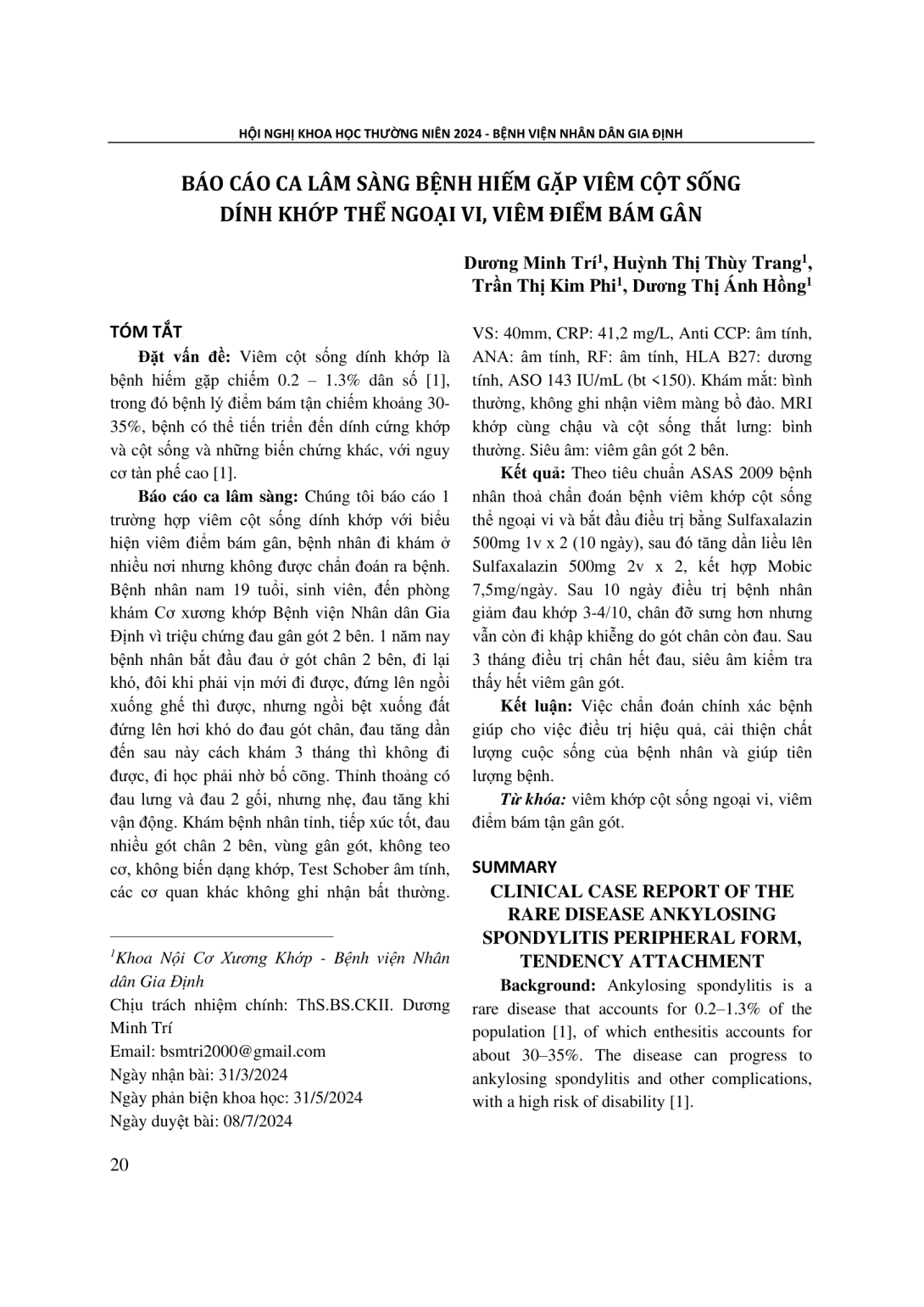
Báo cáo 1 trường hợp viêm cột sống dính khớp với biểu hiện viêm điểm bám gân, bệnh nhân đi khám ở nhiều nơi nhưng không được chẩn đoán ra bệnh. Bệnh nhân nam 19 tuổi, sinh viên, đến phòng khám Cơ xương khớp Bệnh viện Nhân dân Gia Định vì triệu chứng đau gân gót 2 bên. 1 năm nay bệnh nhân bắt đầu đau ở gót chân 2 bên, đi lại khó, đôi khi phải vịn mới đi được, đứng lên ngồi xuống ghế thì được, nhưng ngồi bệt xuống đất đứng lên hơi khó do đau gót chân, đau tăng dần đến sau này cách khám 3 tháng thì không đi được, đi học phải nhờ bố cõng. Thỉnh thoảng có đau lưng và đau 2 gối, nhưng nhẹ, đau tăng khi vận động. Khám bệnh nhân tỉnh, tiếp xúc tốt, đau nhiều gót chân 2 bên, vùng gân gót, không teo cơ, không biến dạng khớp, Test Schober âm tính, các cơ quan khác không ghi nhận bất thường. VS: 40mm, CRP: 41,2 mg/L, Anti CCP: âm tính, ANA: âm tính, RF: âm tính, HLA B27: dương tính, ASO 143 IU/mL (bt <150). Khám mắt: bình thường, không ghi nhận viêm màng bồ đào. MRI khớp cùng chậu và cột sống thắt lưng: bình thường. Siêu âm: viêm gân gót 2 bên. Kết quả: Theo tiêu chuẩn ASAS 2009 bệnh nhân thoả chẩn đoán bệnh viêm khớp cột sống thể ngoại vi và bắt đầu điều trị bằng Sulfaxalazin 500mg 1v x 2 (10 ngày), sau đó tăng dần liều lên Sulfaxalazin 500mg 2v x 2, kết hợp Mobic 7,5mg/ngày. Sau 10 ngày điều trị bệnh nhân giảm đau khớp 3-4/10, chân đỡ sưng hơn nhưng vẫn còn đi khập khiễng do gót chân còn đau. Sau 3 tháng điều trị chân hết đau, siêu âm kiểm tra thấy hết viêm gân gót. Kết luận: Việc chẩn đoán chính xác bệnh giúp cho việc điều trị hiệu quả, cải thiện chất lượng cuộc sống của bệnh nhân và giúp tiên lượng bệnh.
We report a case of ankylosing spondylitis with symptoms of enthesitis. The patient went to many hospitals for examination but was not diagnosed. A 19-year-old male patient, a student, came to the Musculoskeletal Clinic of Gia Dinh People's Hospital because of symptoms of bilateral Achilles tendon pain. One year ago, the patient started having pain in both heels. It was difficult to walk. Sometimes he had to hold on to walk. He could stand up and sit down on a chair, but sitting on the ground and standing up was a bit difficult due to heel pain. The pain gradually increased. After that, he could not walk and had to ask his father to carry him to school. Occasionally there is back pain and pain in both knees, but it is mild and the pain increased with movement. On examination, the patient was conscious, had good contact, had severe pain in the heels on both sides, in the Achilles tendon area, no muscle atrophy, no joint deformity, a negative Schober test, and no abnormalities were noted in other organs. VS: 40mm, CRP: 41.2 mg/L, Anti-CCP: negative, ANA: negative, RF: negative, HLA B27: positive, and ASO: 143 IU/mL (bt <150). Eye examination: normal, no uveitis noted. MRI of the sacroiliac joint and spinal cord: normal. Ultrasound: bilateral Achilles tendonitis. Results: According to ASAS 2009 standards, the patient met the diagnosis of peripheral spinal arthritis and started treatment with Sulfaxalazine 500mg 1 tablet x 2 (10 days), then gradually increased the dose to Sulfaxalazine 500mg 2 tablets x 2 combined with Mobic 7.5 mg/day. After 10 days of treatment, the patient's joint pain decreased by 3–4/10; his leg was less swollen, but he still limped due to the pain in his heel. After 3 months of treatment, his leg pain was gone, and an ultrasound examination showed that the Achilles tendonitis was gone. Conclusions: Accurate diagnosis of the disease helps with effective treatment, improves the patient's quality of life, and helps predict the disease.
- Đăng nhập để gửi ý kiến
